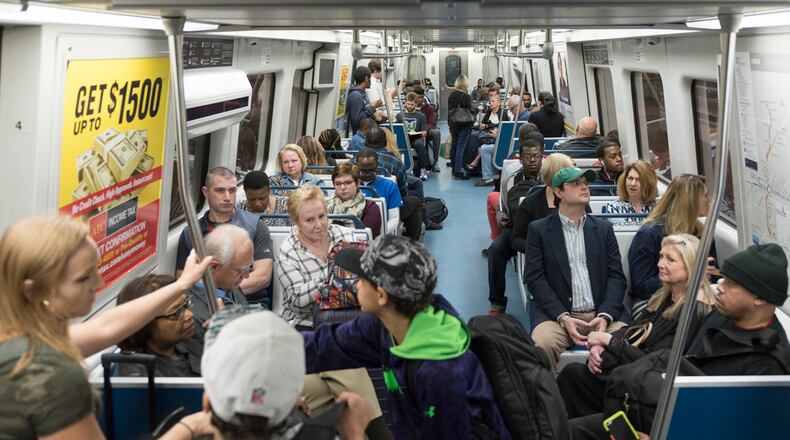Joanne Hughes emerged at the top of the stairs at Marta's Medical Center station and looked around in confusion.
"I just need to get my bearings.”
She'd always wanted to ride Marta to her job, about a mile away from the station on the Glenridge Connector. Now, thanks to Thursday night's I-85 bridge collapse, she was going to have to. Unwilling to battle traffic out of the city in the midst of the disaster, she'd don a pair of tennis shoes, consulted a Marta map and, after one false start when she got on the wrong train, was ready to walk the rest of the way to he job a little before 8 a.m.
Max Erwin wheeled his bike into the Midtown MARTA station shortly after 7 a.m. The station was quiet, with a small handful of commuters waiting and two MARTA police officers. Erwin, who works as a product development engineer in Sandy Springs, said he usually takes MARTA once or twice a week and drives 85/400 the other days.
“Not an option today,” he said. “My commute will be a little bit more of a pain now but at least I work close to a MARTA station, up near the Sandy Springs station, so it’s nice to have that option.”
Erwin said the disaster is a reminder of how critical infrastructure is, and that people should not take it for granted.
“It’s good to have other commute options, otherwise if I didn’t have MARTA right now I’d probably not be working,” he said.
Loree Rose, a self-described “occasional” MARTA rider, bought a Breeze card Friday to head to her job in sales near the perimeter.
“I usually take the Buford connector north to get on 400 and they weren’t saying if it was open or closed, so I didn’t know whether to try to drive or not so I decided to do this,” Rose said.
Rose said she won’t be able to stick with MARTA because she needs her car at work, but added, “We need more public transportation.”
The 7 a.m commute hour on MARTA on Friday was a mix of first-timers and veteran riders. In between helping the former get their bearings, many of the latter expressed surprise that the trains weren't more crowded.
"I think people are waiting to go out later or staying home entirely," said Sam Moody, looking around a half-full car on the North Springs line a little past 7:30 a.m. One thing did surprise her, though, as she made her normal commute from College Park to Medical Center. "There were almost no physical cars on the road!"
Indeed, there were rueful chuckles among a number of MARTA passengers as the train passed by a completely deserted stretch of I-85 northbound near where the collapse had occurred. The disaster had caused some people to alter their commuting or travel plans on the fly and make their first tentative foray onto the city's public transportation system.
That included some of the 30,000 people here for a volleyball tournament downtown. Angela Troupe is a returning vendor at the tournament, who’d driven from out-of-state to a hotel in Dunwoody on Thursday. She’d passed by the site of the collapse a little over an hour before, and spent the rest of the night contemplating something she’d never done before: Taking MARTA downtown.
“This morning is not so bad,” Troupe said as the train pulled into Five Points around 7:15 a.m. and she and several fellow vendors consulted their system maps to figure out how to connect to the east-west line. “But I can’t imagine what it’s going to be like going back tonight!”
The Latest
Featured




